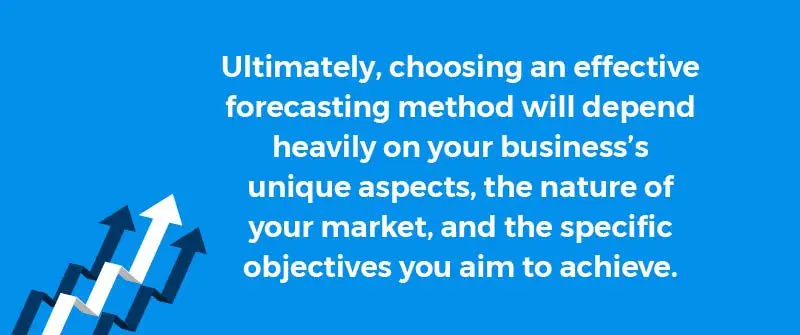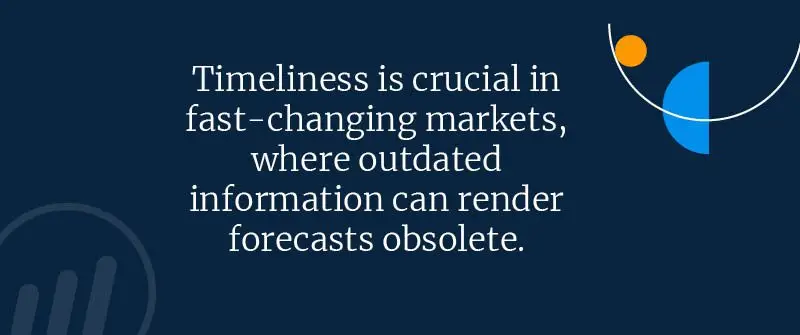
Which Tool Is Used For Forecasting?
Overview of Popular Forecasting Tools
When selecting a forecasting tool, myriad options are available, each with unique strengths and catering to specific needs. Sales forecasting software is crucial for predicting future sales outcomes and integrating with existing systems. Popular tools, such as Excel, IBM Planning Analytics, and SAP Integrated Business Planning, offer robust features for forecasting in various business scenarios. Incorporating budgeting and forecasting services into these tools enhances their utility by enabling businesses to not only predict sales and financial outcomes but also to create detailed budgets and financial plans aligned with strategic objectives. Financial forecasting plays a critical role in business planning, budgeting, and projecting future financial outcomes. Excel, for instance, is ubiquitous and offers ease of use and flexibility, while IBM Planning Analytics integrates complex data and provides sophisticated forecasting capabilities. SAP’s tool is known for its comprehensive planning features, making it a strong candidate for large-scale enterprises seeking integrated budgeting and forecasting solutions.

Comparison of Different Forecasting Tools
Choosing the right budgeting and forecasting software involves examining various criteria, such as ease of use, scalability, and the specific insights your business requires. o forecast sales effectively, it is crucial to utilize historical data, deal stage probabilities, and real-time market insights to predict future sales, make informed decisions, optimize sales processes and resource allocation, and achieve revenue goals. Tools like Excel might suffice for small businesses due to its simplicity and low cost. On the other hand, large enterprises may benefit from the advanced analytics and integrations offered by IBM Planning Analytics or SAP Integrated Business Planning. Understanding these distinctions, along with reviewing Budgeting And Forecasting Examples, helps you make an informed decision that aligns with your business needs and capacities.
Criteria for Choosing a Forecasting Tool
Selecting an effective forecasting tool necessitates thoroughly considering factors such as user interface, scalability, data integration capabilities, and the level of forecasting techniques supported. It’s essential to assess whether the tool can handle your specific data sets and forecasting horizons. Additionally, the tool’s ability to integrate with other business systems and use forecasting data for scenario analysis, real-time forecasting, and creating specialized plans across different departments are critical to consider. The ultimate goal is to choose a tool that meets your current forecasting requirements and can scale as your business grows.
What Is The Most Effective Forecasting Method?
Foreseeing future trends is indispensable for any business to navigate market complexities successfully. As a business owner or entrepreneur, understanding the most effective forecasting method is crucial for ensuring accurate forecasts, contributing to precision and reliability in your predictions.

Definition of Effective Forecasting Method
An effective forecasting method is characterized by its accuracy, consistency, and ability to adapt to varying trends and market conditions. Financial planning is crucial in empowering sales teams to access accurate sales forecast data, customize forecasts, determine win probabilities, predict close dates for deals, and create targeted marketing strategies. Effectiveness is often gauged by its capacity to reduce uncertainty and deliver actionable insights that inform strategic decision-making.
Types of Effective Forecasting Methods
Several methods are recognized for their effectiveness in forecasting:
- Quantitative Forecasting: This method relies heavily on numerical data and statistical techniques. It includes methods such as time series analysis, econometric modeling, and machine learning algorithms.
- Qualitative Forecasting: This approach leverages expert judgment, market research, and comparative analysis. Techniques include the Delphi Method, market research, and panel consensus forecasts.
- Mixed-Method Forecasting: This method combines quantitative and qualitative techniques, aiming to harness the strengths of both approaches and provide a holistic view of potential future trends.
Factors Influencing the Effectiveness of Forecasting Methods
Critical factors impact the effectiveness of forecasting methods. These include the data’s quality and relevance, the chosen model’s suitability to the specific industry context, and the expertise of the individuals interpreting the data.
Moreover, the forecasting method’s adaptability to update and incorporate new data frequently, alongside technology integration like forecasting software, plays a pivotal role in maintaining forecasting accuracy.
Ultimately, choosing an effective financial forecasting method will depend heavily on your business’s unique aspects, the nature of your market, and the specific objectives you aim to achieve. Businesses strategically selecting and customizing their forecasting approach to incorporate these elements are best positioned to seize market opportunities and mitigate potential risks.

What Are The Three Different Types Of Sales Forecasting Software?
When selecting the right forecasting software for your business, understanding the available types is crucial. Budgeting and forecasting software is essential for managing financial details, covering revenue estimates, operating expense planning, and financial budgeting. There are three main categories of forecasting software that each serve distinct purposes and offer unique benefits. Let’s delve into what these categories are:
1. Time Series Forecasting Software
Time series forecasting software is designed to analyze sequences of data points collected over time intervals. Analyzing past and present sales data is crucial for accurate time series forecasting, as it helps predict future sales outcomes and estimate sales revenue. This method is ideal for demand planning, sales forecasting, and financial budget projections. Tools like Excel’s native forecasting functions and more advanced platforms like Tableau and R are excellent for time series analysis. They allow businesses to identify trends, seasonal patterns, and cyclic behavior, offering a clear view of future expectations based on historical data.
While time series software can be highly accurate, it requires significant historical data to be effective. This could disadvantage new businesses or those with limited past data entering new markets.
2. Causal Forecasting Software
Causal forecasting software delves deeper by incorporating external factors such as economic indicators, market trends, and other external variables that might influence future outcomes. Forecasting solutions offer the ability to analyze historical data, identify trends, and predict future outcomes, providing real-time visibility of sales pipelines and support for an entire tech stack. Regression analysis tools like IBM SPSS and SAS analytics solutions are popular choices for causal forecasting.
The major benefit here is the ability to create more nuanced and multifactorial forecasts. However, incorporating multiple variables can complicate the modeling process, and the accuracy of the forecast heavily relies on the quality and relevance of the external data being used.

3. Qualitative Forecasting Software
Unlike the more quantitative approaches, qualitative forecasting software focuses on gathering expert opinions and market research to predict future outcomes. These tools empower sales teams to make informed decisions, optimize their sales process, and achieve revenue targets through forecasting and real-time pipeline management. Tools like Qualtrics or SurveyMonkey provide platforms to harness expert insights, which can be especially useful in new product forecasting or scenarios where historical data is scarce.
The subjective nature of qualitative forecasts can be both an advantage and a disadvantage. While it allows for flexibility and expert intuition, it can also introduce bias and subjective errors, potentially skewing the forecast results.
Ultimately, the choice of forecasting software depends on your specific business needs, the availability of historical data, and the external factors influencing your industry. Understanding these three types of software can help you make an informed decision and ensure that your forecasting efforts are efficient and effective.
What Is The Best Source Of Information When Forecasting?
Forecasting is as good as the data it relies on; therefore, determining the best source of information and utilizing the best forecasting software is critical for achieving accuracy and reliability. Reliable data is the backbone for effective forecasting methods, enabling businesses to make informed decisions and confidently mitigate risks.
Importance of Reliable Data for Forecasting
The importance of using reliable data in forecasting cannot be overstated. Poor-quality data can lead to inaccurate forecasts, significantly impacting your business, including financial losses and compromised strategic planning. Reliable data ensures that your models and analyses reflect actual conditions, reducing the risk of unforeseen variances that could disrupt your business operations.
Characteristics of a Good Information Source
Identifying a good information source involves evaluating several key characteristics. First and foremost, data should be accurate and up-to-date. Timeliness is crucial in fast-changing markets, where outdated information can render forecasts obsolete. Another important factor is the comprehensiveness of the data. A good source should provide a detailed and holistic view, covering all relevant aspects that could impact your forecast.
Data consistency is another vital attribute. Reliable sources maintain consistent data collection methodologies, which helps maintain the integrity of forecasting models. Lastly, accessibility is critical. Data should be readily available and easily integrated into existing forecasting systems without significant delays or additional costs.

Examples of Reliable Sources for Forecasting
Several reliable sources can significantly enhance the accuracy of your forecasts. Government databases, such as those provided by the Bureau of Economic Analysis (BEA) and the Federal Reserve, offer invaluable data on macroeconomic indicators crucial for long-term planning. Industry reports from market research firms like Gartner and Nielsen provide sector-specific insights that can be integrated into your forecasting models for more targeted analysis.
Your historical data is another powerful source. Leveraging past performance metrics can offer a realistic baseline for future projections. Additionally, financial market data providers like Bloomberg and Reuters are indispensable for businesses that need real-time data to make swift, informed decisions.
Want to achieve your business goals with a solid financial plan? Explore Milestone Inc.’s budgeting and forecasting services, specifically designed for small businesses. Learn more about how we can support your success.
Related Content

What Is Incremental Budgeting?
Find out what incremental budgeting is and how it differs from other budgeting methods. Transform your budgeting process by partnering ...

What Is Financial Planning & Analysis?
Learn about financial planning and analysis to transform your business. Milestone combines deep financial insight with hands-on support so businesses ...

What If Analysis: Definition, Benefits, And How To Perform One
What-if analysis is a strategic decision-making tool used in financial planning to evaluate the impact of various hypothetical scenarios on ...
Stay in the know